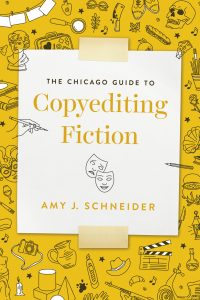Five Questions with Amy J. Schneider, author of “The Chicago Guide to Copyediting Fiction”
Released this month, The Chicago Guide to Copyediting Fiction has taken the copyediting world by storm. Although The Chicago Manual of Style is widely used by writers and editors of all stripes, it is primarily concerned with nonfiction, a fact long lamented by the fiction community. Amy J. Schneider, a veteran copyeditor who’s worked on bestsellers across a wide swath of genres, delivers a companionable editing guide geared specifically toward fiction copyeditors—the first book of its type. Schneider spoke with us about her career as a copyeditor, the inspiration for the book, and what she’s up to next.
How did you wind up working as a copyeditor, and what do you love about it?
My degree is in graphic art, and after college, I worked in the film prep department at a printing company for several years. I loved the work but didn’t enjoy the job, so I started looking for something I could do independently, at home. I’d done some editing as a student and enjoyed it, so I did some research and study, and contrary to the usual advice to get in-house experience first, started my freelance business from scratch. For about a decade most of my work was college textbooks, but the mix gradually transitioned more toward fiction. These days my work is about 60% fiction and 40% trade and scholarly nonfiction, all for publishers and university presses.
I love the independence and flexibility of being my own boss and being paid to help make books. I get to work on some pretty cool projects. I also value my role in helping to shape language to be clear, concise, and inclusive.
The Chicago Guide to Copyediting Fiction is your first book, and one of the first books devoted specifically to fiction copyediting. How did you decide that you wanted to write this book?
When I started giving conference presentations and webinars on copyediting fiction, I discovered that there weren’t really any books devoted completely to the topic and geared toward editors, just bits and pieces here and there. I mentioned this in a session and someone said that maybe I should write one! The idea sat on the back burner for a while . . . Then I gave a presentation at the EFA conference in Chicago in August 2019, and afterward Mary Laur from the University of Chicago Press came up to talk with me. That conversation led to a book proposal, a contract, and eventually a finished manuscript. I fleshed out several blog posts and extensive speaker notes from my presentations. And learned a lot along the way! If you want to learn more about a subject, write about it.
What do you most hope readers will take away from your book?
Editors and editing have a (misguided) reputation, particularly among laypeople and newer editors, for being about “correctness,” rules, and absolute right or wrong. But it’s really about communication and helping the author convey their information or tell their story. Language is constantly evolving, and especially in fiction editing, we need to embrace that. Formal, structured English has its place, but rarely in fiction. The mindful fiction copyeditor learns to be extremely flexible.
Where will your research and writing take you next?
I’m not naturally driven to write more than the occasional blog post or article if I feel the need to get something out of my brain and onto the page or the screen; polishing something that’s already written is more in my wheelhouse. But my revamped website will eventually have a blog where I can deposit my thoughts, both new ones and those that didn’t make it into the book. I’m also happy to guest blog, write articles for newsletters, and so on. And of course, if eventually there is a need for a second edition of The Chicago Guide to Copyediting Fiction, I already have thoughts on how I might update it.
What are the best books you’ve read lately?
I have a dirty little secret: I rarely read for pleasure anymore! I spend so much time reading when I’m at my desk that when I’m off the clock, I want to do all the other things in life: go for a walk, do activities with my dogs, hang out with friends, and so on. Besides, I read plenty of quality fiction while I’m working! But of the books I’ve worked on . . . I really enjoy Karen Rose’s series. Her Sacramento series (Say You’re Sorry, Say No More, and Say Goodbye) was my introduction to her writing, and I was hooked. Kate Furnivall writes rich and lovely historical fiction; she’s with a different publisher now and I miss working on her books. Mark Greaney’s Gray Man series (Burner being the most recent installment) is amazing as well; the characters are fascinating and the plots are action-packed. I’m lucky to work with so many fabulous authors!

Amy J. Schneider is a copyeditor with twenty-eight years of experience and the owner of Featherschneider Editorial Services. She has copyedited approximately five hundred novels and anthologies, including bestsellers in a variety of genres. Visit her website at https://www.featherschneider.com.
The Chicago Guide to Copyediting Fiction is available now from our website or your favorite bookseller.
